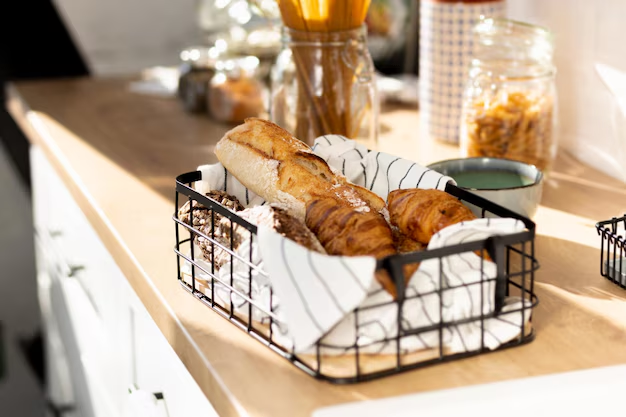Does Storing Bread in the Refrigerator Extend Its Shelf Life? 🍞
Bread—the quintessential comfort food—is a staple in many households. Whether it’s a perfectly toasted slice in the morning or a crusty loaf accompanying dinner, its perishable nature frequently presents a storage conundrum. Many people store bread in the refrigerator, believing it prolongs freshness. But does keeping bread chilled truly make it last longer, or are there better methods? Let’s delve into the nuances of bread storage and uncover effective strategies to maximize its shelf life.
The Science of Bread Spoilage
Bread spoilage is influenced by several factors, primarily time, temperature, and humidity. Understanding these elements is crucial in determining the best storage methods.
The Role of Staling
Staling refers to the process where bread becomes dry and hard due to moisture redistribution within the loaf. This begins soon after baking when starch molecules realign, leading to a firmer texture and reduced palatability. Interestingly, refrigeration, while potentially slowing mold growth, accelerates staling by intensifying this realignment, often resulting in prematurely dry bread.
Mold and Microbial Growth
Mold is a significant spoilage culprit, thriving in warm and humid environments. Refrigeration can inhibit mold growth by creating less favorable conditions, which is why people often turn to this method in hopes of extending bread's edibility.
To Refrigerate or Not to Refrigerate?
Given the dual nature of refrigeration's impact—slowing mold but hastening staling—the decision to chill bread isn’t straightforward.
Pros of Refrigerating Bread
- Mold Prevention: Lower temperatures slow down mold growth, potentially extending the bread's mold-free period.
- Prolonged Storage: For certain types of bread, especially those low in preservatives, refrigeration can extend freshness beyond room temperature storage.
Cons of Refrigerating Bread
- Accelerated Staling: Bread becomes dry and crumbly more quickly, which may not be suitable for everyone’s taste preferences.
- Texture Alteration: The ideal softness and chewiness of bread are often lost, impacting dishes like sandwiches where texture is critical.
Alternative Bread Storage Methods
If refrigeration results in unsatisfactory bread, consider the following options for maintaining its optimal freshness:
Room Temperature Storage
Room temperature is effective for short-term storage, usually up to four days. Store bread in a breathable container, like a paper bag or bread box, to prevent moisture buildup and allow for ventilation.
Freezing for Long-Term Freshness
Freezing halts staling and mold growth altogether. Wrap bread tightly in plastic or foil and place it in a freezer-safe bag. This preserves its texture and flavor, making freezing a superior method for long-term storage when compared to refrigeration.
Tips for Freezing Bread
- Slice Before Freezing: This allows for convenient thawing of individual pieces as needed.
- Double Wrap: Use an extra layer of protection to prevent freezer burn, maintaining the bread's taste and texture.
Bread Varieties and Their Ideal Storage
Different types of bread react uniquely to varying storage methods. Here’s a guide to help you store common bread types:
White and Whole Wheat Bread
These are best kept at room temperature for quick consumption or frozen for long-term use. Avoid refrigeration for daily use to prevent staling.
Gluten-Free Bread
Gluten-free bread, often lacking preservatives, benefits more from refrigeration to prevent mold. However, mind the accelerated staling; slice and freeze for optimal texture and longevity.
Artisan and Sourdough Loaves
These loaves are robust and usually last longer on the counter due to their hard crust. Avoid refrigeration; instead, place them in a bread box or wrap them in a towel. Freeze for extended storage.
Practical Tips for Bread Longevity 🌟
Ensure your bread stays fresh longer with these practical storage tips:
- Rotate Stock Regularly: Use older bread first to ensure none goes stale prematurely.
- Avoid Direct Sunlight and Heat: These conditions accelerate spoilage, including mold.
- Proper Chilling: If opting for refrigeration, seal bread in an airtight container to minimize exposure to cold air and reduce staling.
Bread Storage Summary 🧾
Here's a quick reference guide to optimal bread storage methods tailored to various circumstances:
| Storage Method | Pros | Cons | Best For |
|---|---|---|---|
| Refrigeration | Mold prevention, longer storage | Hastens staling, texture loss | Short-term (low humidity areas) |
| Room Temperature | Convenient, maintains texture | Limited to a few days | Daily usage |
| Freezing | Stops staling and mold entirely | Requires thaw time | Long-term storage |
The Final Slice on Bread Storage
In the quest to maximize bread’s lifespan while maintaining its palatability, freezing emerges as the winner for long-term preservation, alongside traditional room temperature storage for immediate use. While refrigeration offers mold prevention, it compromises texture, making it less ideal for those who cherish bread's original mouthfeel.
Ultimately, your ideal bread storage solution hinges on consumption patterns and personal preference. Whether you choose to chill, freeze, or keep your loaf at room temperature, being armed with the right approach ensures that every slice is as delicious as the first.
Embrace these storage strategies to enjoy fresher, tastier bread—one slice at a time! 🥖✨
